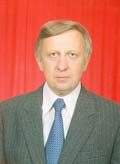Contents: 2024 | 2023 | 2022 | 2021 | 2020 | 2019 | 2018 | 2017 | 2016 | 2015 | 2014 | 2013 | 2012 | 2011 | 2010 | 2009 | 2008 | 2007 | 2006 | 2005 | 2004 | 2003 | 2002 | 2001
2008, 15
Approximation technique for numerical description of some low-frequency sounds of speech
language: Russian
received 15.05.2008, published 04.08.2008
Download article (PDF, 335 kb, ZIP), use browser command "Save Target As..."
To read this document you need Adobe Acrobat © Reader software, which is simple to use and available at no cost. Use version 4.0 or higher. You can download software from Adobe site (http://www.adobe.com/).
ABSTRACT
A method for speech recognition is suggested. It is based on approximation of not perfect periodical function with a set of modes with slowly (with respect to carrier frequencies) varying amplitudes. The technique is applied to analysis of eight low-frequency sounds of speech from eight respondents. The database for amplitudes of separated modes is created and the system for identification of eight low-frequency sounds is developed. Testing of the system shows the level of recognition is 85-95 percents.
Key words: speech recognition, approximation.
11 pages, 1 figure
Сitation: V. V. Mitsianok. Approximation technique for numerical description of some low-frequency sounds of speech. Electronic Journal “Technical Acoustics”, http://www.ejta.org, 2008, 15.
REFERENCES
1. Галунов В. И., Лобанов Б. М., Загоруйко Н. Г. Синтез и распознавание речи. Труды XIV сессии Российского акустического общества, 2004.
2. http:// intsys.msu.ru/invest/speech/research. Интеллектуальные системы. Официальный сайт кафедры МТИС и лаборатории проблем теоретической кибернетики механико-математического факультета МГУ.
3. Kuhl P. K., Iverson P. Linguistic experience and the «perceptual magnet effect». In Strange W. Speech perception and linguistic experiment, p. 121–154.
4. Галунов В. И., Гарбарук В. И. Акустическая теория речеобразования и системы фонетических признаков. Материалы международной конференции «100 лет экспериментальной фонетике в России», 1–4 февраля 2001 г.
5. Галунов В. И., Соловьев А. Н. Современные проблемы в области распознавания речи. Информационные технологии и вычислительные системы, №2, 2004.
6. Kraft D. Speech perception. J. Phonetics, vol. 7, p. 279–312, 1979.
7. http://www.auditech.ru; http://www.smartphone.ru; http://www.summatech.ru; http://www.sakrament.com; http://www.speechpro.ru; http://www.opencom.ru; http://www.istrasoft.ru/speech.html
8. Elinek F. Разработка экспериментального устройства, распознающего раздельно произнесенные слова. ТИИЭР, т. 73, №11, c. 91–99, 1985.
9. http://www.digest.univers.cv.ua/cnp_start.html
10. Галунов В. И. Современные речевые технологии. http://g-klishin.narod.ru/works.html
11. Дьяконов В. Абраменкова И. МАТЛАБ. Обработка сигналов и изображений. Специальный справочник. С.-П.: Питер, 2002.
12. http://www.prodav.narod.ru/wavelet
13. Зигмунд А. Тригонометрические ряды, т.1. Перев. с англ. М.: Мир. 1965.
 |
Vyacheslav Mitsianok born on 17 of Sept., 1951 in Belarus. Graduate Byelorussian State Univ. in 1971 in theoretical physics. Post-graduate course 1971-1974 at Academy of Science of Belarus. PhD from 1975. At present Docent of Mathematics in Polessian State Univ. Pinsk, Belarus. e-mail: mitsianok(at)mail.ru |
